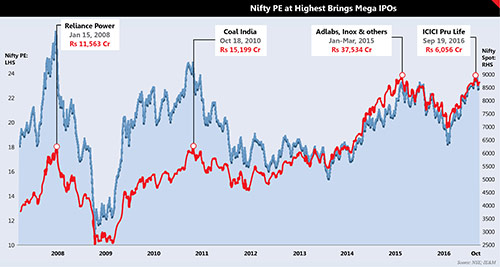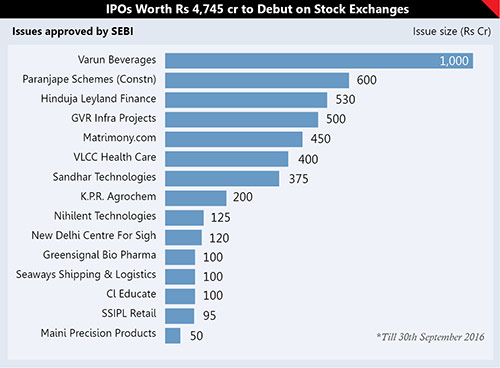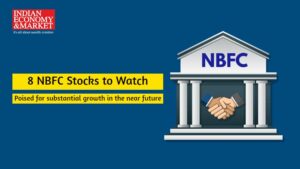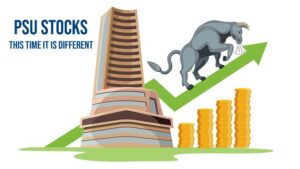Whenever the secondary market booms, come the promoters of companies with their IPOs, enthusiastically supported by pink papers. Investors are lured in such a way with the euphoric feelings and intense excitement that, even after having burnt their fingers in the past, still they come again believing the party will continue ad infinitum.
But old habits, and dreams, die hard and this adage specially fits with the investing pattern of Indian retail investors. Like always, the index PE is at record highs, and the past trend shows that anyone who bought equity index at these high levels, had to wait substantially longer, yet the successive IPOs this year have been able to garner more funds than their targets.
Is this the right time to buy or increase the equities allocation? When we posed this question, many brokers and analysts said in affirmative. But seasoned marketmen, who have been successfully trading for many a seasons told to look at the chart on the right.
By IE&M Research
Indian investors’ fetish for public equity offers (initial public offers – IPOs) by companies seeking listing on bourses is at its highest: nine year high in the first half of the year to September 2016. The IPO market is booming as euphoric retail investors are eager and willing to hand over money sacks in exchange of allotment of shares in the public issues.
Old habits, and dreams, die hard. In stock markets, they come again believing the party will continue ad infinitum. So what if boom this time is followed by a slump, which it does repeatedly. They nurse and curse their long-term buy-high
IPO investments for the next booming season to come sometime in the future.
It’s proved, time and again. When large public issues hit the market, they hit it hard. The market goes into tailspin and finicky investors recoil. Mostly, retail equity investors are ecstatic when the stocks and indices are selling at expensive valuations on the street based on earnings multiples, yield and price to book consideration. But, expectedly and amazingly, companies and public issue book running managers not only find it easy to sell, but they are able to sell shares at higher prices when the buying public is rapturous. Their optimism and enthusiasm pumped by ever obliging and trumpeting financial media. The benchmark Nifty at the National Stock Exchange has moved up nearly30% from budget-day low on 29 February, 2016 till date. Rising tide lifts all boats. The last six months’ rally has enabled equity mutual funds also to attract investors who have poured in Rs 22,233 Cr (net inflows) for the six months ended September 2016 that has swelled mutual funds’ equity assets under management to Rs 4.68 tn as on September 21016 from Rs 3.86 tn on March 2016.
The ICICI Prudential Life Insurance IPO hit the market in the last week of September 2016 with Nifty PE at 24, the highest in six years. On listing, the shares dropped 12% below the issue price even though the IPO was oversubscribed 10.48 times. The issue was helped by positive media announcements. On the listing day on September 29, 2016, the pink papers carried a news headline suggesting US-based Wal-Mart Stores to buy a minority stake in e-commerce firm Flipkart for $1 bn. It induced the impression that a deal like that would pit Wal-Mart against its US rival Amazon, which has been expanding rapidly in a market that Bank of America Merrill Lynch forecasts will surge to $220 billion in value of goods sold by 2025 from about $11 billion last year.
This news is yet to be confirmed as no headway has been reported beyond this headline. Even before this news was flashed across business TV channels, another one was making rounds in print media. It was a PTI report (and the story was carried very prominently by almost all the papers) that confirmed more than 70% of the newly-listed companies were trading well above their issue price, giving handsome returns of up to (hold your breath) 98%. But the news item did not highlight that there were at least five stocks that were trading 30% below their issue price. The emphasis was on the performance of microfinance player Ujjivan Financial Services which made its stock market debut in May and was trading 98.35% higher than its IPO price. But it happens, not all the IPOs give similar kinds of returns on listing. Still the game was successful and the Rs 6,057-cr public issue was oversubscribed 10.48 times.
On earlier occasions, investors’ fancy and India’s biggest share sale was in the energy sector. This time, in 2016, financials have flooded the street with ICICI Prudential Life Insurance being the largest IPO of the year. In the run up to ICICI Pru IPO, microfinance sector was hailed as the sunrise sector and a couple of issues from this sector received good response raising record sums. Equitas Holdings raised Rs 2,177 crore and Ujjivan Financial Services raised Rs 882.5 cr in the month of April.
“Market tops are characterized by extreme euphoria, or “irrational exuberance” in the words of Warren Buffet. True, valuations are extended, but from an investor’s standpoint, we are not there,” one seasoned stock broker said.“The optimism about the economy and the markets as a whole and analysts’ earnings expectations are on the rise. That’s interpreted to stay in the game,” he said. “A major revival was witnessed in the IPO market after nearly four dismal years and 2016-17 looks promising. Even in the public bonds market, 10 issues raised Rs 20,249 cr which is significantly higher than six issues, raising Rs 2302 cr in the corresponding period of the preceding year,” according to Pranav Haldea, Managing Director of Prime, the premier database on the primary capital market.
During any period, the company promoter’s credibility and the sector it belongs to play an important role. Historically, each IPO season (which has no set time gap between two) had its own favorite sector. But beside the above two factors what is more important is the Index PE and the valuation at which the companies put their shares on sale. Valuation is certainly discussed by one and all but the Index PE is ignored by both the media and the investors as well.
A detailed study shows that Index PE plays a very crucial role in the kind of returns an investor gets out of his primary market investment and even more important factor is that it decides the time frame he has to wait to earn that return. Yet the most glaring trend that has been observed is that after every mega IPO, secondary market has subsequently tanked and took a long time to come back to even level. Sometimes half a decade.
In the first quarter (Jan-Mar) of 2015, the Nifty made historical high of 9,000 following BJP’s victory in elections and regime change at the centre. This high was accompanied by an assortment of IPOs in leisure, services and infrastructure sector, the most prominent being Adlabs Entertainment, INOX Wind, VRL Logistics, UFO Movies, PNC Infratech and Syngene International. Many of them are trading below issue price. (See table)
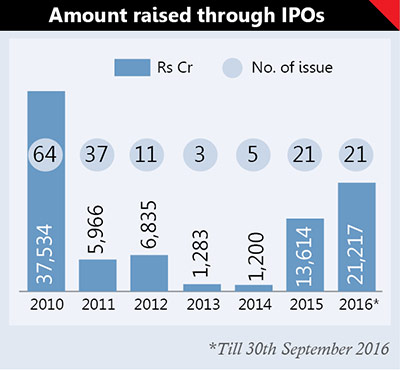 Going back a little further, in October 2010, Coal India Ltd raised over Rs 15,000 cr at a price of Rs 245/- per share. The benchmark index Nifty collapsed about 25% in the next one year. And the same way, in January 2008, Reliance Power Ltd, the largest IPO so far that received commitment of around Rs 1,45,080 crore against issue size of Rs 11,700 crore. This was helped by pink paper’s headlines claiming that the issue was sold in one minute as Warren Buffet had
Going back a little further, in October 2010, Coal India Ltd raised over Rs 15,000 cr at a price of Rs 245/- per share. The benchmark index Nifty collapsed about 25% in the next one year. And the same way, in January 2008, Reliance Power Ltd, the largest IPO so far that received commitment of around Rs 1,45,080 crore against issue size of Rs 11,700 crore. This was helped by pink paper’s headlines claiming that the issue was sold in one minute as Warren Buffet had 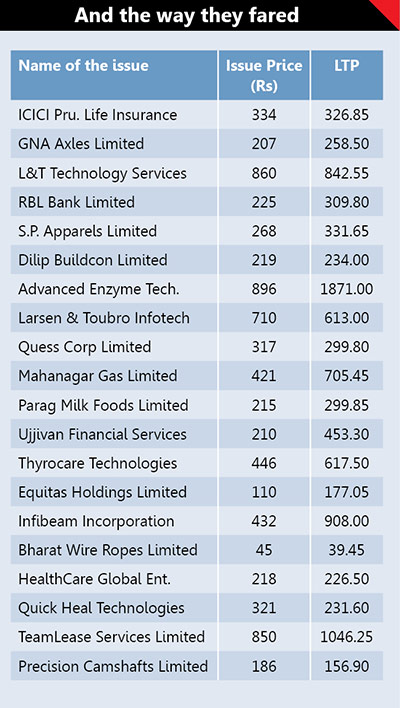 subscribed $1 bn at Rs 450 per share in the IPO. The Nifty index tanked more than 30% over the next six months and a further 25% drop in October 2010 following sub-prime financial crisis in the USA and banking crisis in the Euro area.
subscribed $1 bn at Rs 450 per share in the IPO. The Nifty index tanked more than 30% over the next six months and a further 25% drop in October 2010 following sub-prime financial crisis in the USA and banking crisis in the Euro area.
Value investors look at the index in terms of absolute number. They use most popular index PE ratio that takes earnings of all the constituent companies into consideration before making an investment decision. Whether the index is cheap or expensive should be judged on the basis of its PE ratio rather than the absolute value. The ratio indicates the extent to which earnings of the constituent companies are covered by its price. In other words, the index companies’ earnings remaining constant, it will take you that many years through to recover the cost of buying. The higher the PE, the longer the time it will take you to recover the investment.
Analysts have not been as bullish about corporate earnings growth rate as in the past six years, buoyed by hopes the rate cuts by the Reserve Bank of India would help corporate balance sheets and change the colour of banks’ bad debts. According to Bloomberg, BSE Sensex-30 companies’ EPS (blended forward) is likely to grow 30% in the next fiscal, the highest growth rate forecasted in the last six years. That may be one of the reason index PE is at record highs. But, the past trend shows that anyone who bought equity index at these high levels, one had to wait substantially longer to get even because the markets have tended to correct accompanied by mean reversion in PE (see chart).
Although there is nothing wrong if promoters throng the market when going in secondary market is good, but the last seven months primary market this year the trend tell a different and an unusual story which only indicates that in the IPO garden, if we can call it one, all is not so rosy as it seems to be. The data clearly show that with all this euphoria created by pink papers the truth is entirely opposite. Companies are supposed to raise money for expansion, to have a healthy working capital or to take the enterprise to another level.
However, this year it was not for capital formation rather it is mostly to give a pass to the large number of private equity firms and investors (those invested after 2009 super hyped election) who had been waiting for long to get an exciting and beneficial exit from companies on completion of their investment horizon. In a way, it was necessary since PEs supports small businesses when they are in need of capital and exit for them is important.
But surprisingly, even during this highly charged atmosphere of IPO raining, the data suggest that of the Rs 16,980 crore raised through public issues in the last six-month period only 23% accounted for fresh capital raised by companies for future expansion and the rest 77% were accounted for by the OFS (offer for sale) process. This proceeds went to the existing equity shareholders who sold their shares in these issues, mostly promoters, venture funds, the government, and other investors. The amount raised through fresh capital stood at only Rs 3,797 crore. Some larger issues like Rs 1,038 crore of Mahanagar Gas Ltd, Rs 1,236 crore of L&T Infotech Ltd, and the Rs 6,056-crore issue of ICICI Prudential Life Insurance did not see any fresh capital raised and the entire component of the IPO was OFS. In 2007-08, money was raised for investment in greenfield or brownfield projects and expansion of businesses. This year so far it is being utilised by private equity investors to make an exit from their investments made 5-6 years ago.
Again, in a way this is not a very positive sign. So either the company promoters are scared or they have this doubt that the market is right now not ripe to raise money for new projects and the investing community with such huge upward move still not willing to invest in a new company.
Sebi to cut IPO listing time to four days
Sebi Chairman UK Sinha has hinted that the regulator would reduce the timeline for IPOs to four days from six days. Last year, the regulator had shortened listing time to six days from 12 days. In 2010, the time between the closing of an IPO and listing was 22 days. As retail investor participation in the primary markets has picked up significantly after a gap of several years Sebi wants companies and investment bankers to exercise caution on disclosures and IPO pricing. Three years ago, more than two third of the issues were trading continuously below the issue price and retail investors had left the primary markets, but now more than two third of the issues are trading above the issue price. Sebi is also planning to expedite delisting of companies that have been suspended by the stock exchanges for a long time.






